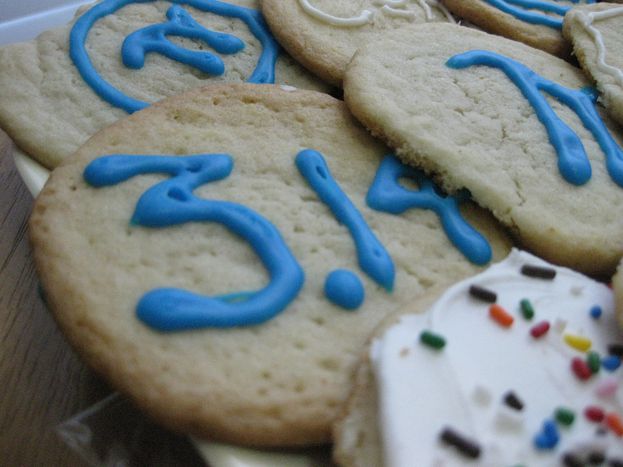
'Pi Day': why does the world celebrate the number contained by the universe?
Published on
Translation by:
Alice SanchezMystical, irrational and transcendental, the mysterious Pi number still brings up questions more than two thousand years old. During the celebration, the American nomenclature ‘March 14th 2015’ coincides with the first five digits of π, what makes of this day one of the most geek days of the international schedule.
From the very first moment I want to make it clear: I get along with Mathematics as well as with my cat Mixolidia, who I admire but cannot understand. However, the science is inclusive and this personal lack does not stop me enjoying myself of one of the most funny geek moments of the schedule: the 14th March, when everybody celebrated the Pi Day.
This crazy day started to be celebrated in 1998 due to the numeric fanatism of the physicist Larry Shaw. The date, furthermore, coincides with the birthday of no less Albert Einstein, who was not exactly recognised by his Mathematics talent. Although this is relative, of course.
But what is the funny thing? So well, this play is given by the coincidence of the Anglosaxon nomenclature March 14th 2015 (3/14/15) and the first five digits of π: 3.141… And even more if we consider the very first five digits (9,2,6,5 and 3), the journey will have a brief moment of mathematic precision just of seven seconds before nine and twenty-seven in the morning.
And which is the most appropriate way to celebrate this date? The Mathematics department of the University of Harvard, for example, called groove to the decimals with an hymn in its honour. A popular farmer in YouTube, Derek Klingerberg, spur on his cows so as to make the Greek letter.
Nevertheless, the international nerdism consecrated so several practices as unofficial, strictly speaking, it does not exist any clear tradition which leads us. In this way, and as we may, let’s entrust ourselves in such an elegant and contemplative task which allows us to discover some curiosity associated to this no massive festivity.
As everybody knows, the Greek letter π represents a fundamental constant (from the Euclidean geometry) which relates to the circumference of a circle with its diameter. It is a number that, more than mystic, is irrational: it does not have a finite decimal representation. This means that we will never know its complete value, the finished list of its decimals from the first to the last one, due to its infinity. In another way, any sequence, of any length, is contained among the pi decimals, which is an clear idea of Borges and his aleph.
 It appears innumerable times in mathematicm physics and geometrical equations (and even in music). It is essential to know its value to solve them, and the more complex is the calculation, the more quantity of digits it is required. Currently more than 10 billion of pi decimals are known, which started to discover scientists more than two thousand years ago, including Arquimedes himself and more recently Chao Lu, a Chinese man which the capacity of reciting the first 67,890 decimals (he lasted something more than 24 hours in doing it). It has been said that this symbol can contain the universe itself, and it is a so frightening idea as fascinating. Pi is everywhere! In every circle; in this type “o”; your mobile number is somewhere in pi; your name, your lover’s, siblings’, or your dog’s name; that deck of cards in a window shopper of Mirzapur; the quantity of times you entered to a restaurant and you drinked water; the exact expression of that thing you dreamed this morning and if we take randomly a play of Shakespeare and we attribute a number for each letter, the numeric sequence represented would be contained in pi. In fact, it does exist calculators able to search any expression among the first 200 million of digits of this puzzling number.
It appears innumerable times in mathematicm physics and geometrical equations (and even in music). It is essential to know its value to solve them, and the more complex is the calculation, the more quantity of digits it is required. Currently more than 10 billion of pi decimals are known, which started to discover scientists more than two thousand years ago, including Arquimedes himself and more recently Chao Lu, a Chinese man which the capacity of reciting the first 67,890 decimals (he lasted something more than 24 hours in doing it). It has been said that this symbol can contain the universe itself, and it is a so frightening idea as fascinating. Pi is everywhere! In every circle; in this type “o”; your mobile number is somewhere in pi; your name, your lover’s, siblings’, or your dog’s name; that deck of cards in a window shopper of Mirzapur; the quantity of times you entered to a restaurant and you drinked water; the exact expression of that thing you dreamed this morning and if we take randomly a play of Shakespeare and we attribute a number for each letter, the numeric sequence represented would be contained in pi. In fact, it does exist calculators able to search any expression among the first 200 million of digits of this puzzling number.
Among most of the data, curiosities, applications and analysis that can be found online about this number, one that entertain me the most (and it is guaranteed immediate enjoying, without needing the understanding of Mathematics) is related with the mnemonics rules. The intention is to build a words sequence with the exact quantity of letters which represent the different pi decimals: “How I need a drink, alcoholic in nature, after the heavy lectures involving quantum mechanics”, is one of the most popular one.
Mixolidia, although its feline charm, its catlike secret and its tigress agility, has not awaken my interest in the scientific community as the Greek letter has done from now, the indisputably star of the Mathematics during the last two thousend years. However, I still mantain that a strange common denominator puts them together: this inexpicable fascination for an evident beauty, clever, self-sufficient and at the same time hard to understand.
Translated from 'Pi Day': ¿por qué el mundo celebra al número que contiene el universo?



